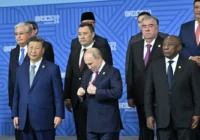The recent global landscape has been reshaped by a number of small groupings, popularly known as “minilaterals.” These are clusters of like-minded nations with shared threat perceptions and strategic interests. Growing awareness of the inability of large unitary organizations, like the United Nations, to build peace and resolve conflict has led to the proliferation of these organizations.
Nowhere is this more visible than in the Indo-Pacific. Most prominent is the revived Quadrilateral Security Dialogue (Quad), a strategic security forum between the United States, India, Japan and Australia. The 2021 foundation of the AUKUS (Australia, UK and US) technology-sharing alliance has also manifested the phenomenon of minilateralism. In both cases, increasing cooperation has been spurred on by an increasingly threatening China.
It remains to be seen whether these organizations will be able to contribute to stability in the region by improving cooperation and governance or destabilize relations by building up opposed blocs.
The need for nuanced international cooperation
Minilaterals are emerging as a consequence of the shifts in underlying power in the region. China, certainly, has become more belligerent in the last 30 years, but other nations such as South Korea, India and Singapore have been growing and are also asserting their influence in a region no longer dominated by Western powers. For its own part, the West, especially the United States, France and the United Kingdom, has been making efforts to maintain its foothold in the region. These shifts in the underlying power structure have created the need for an intricate cooperation structure that can balance so many overlapping interests.
On the economic front, diplomatic prospects widened with the signing of the Indo- Pacific Economic Framework (IPEF) by 13 countries with interests in Southeast Asia, including the QUAD allies headed by the US, last year. The signatories hope to advance sustainable economic development and strategic inclusiveness for the overall peace and stability of the region.
“The future of the 21st century is largely written in the Indo-Pacific,” observed US President Joe Biden. The IPEF reflects the spirit of the Trans-Pacific Partnership as a part
of the US’s so-called “Pivot to Asia.” policy as manifest in the revamped entity of the QUAD. The US has also been pursuing US-Japan-South Korea and US-Japan-Philippines trilateral dialogue. Meanwhile, Australia is strengthening ties with India and Indonesia.
Pou Sothirak, an expert on International affairs at the Asian Institute of Policy Studies, cites a breakdown of trust in the ability of multilaterals to operate effectively and represent member nations’ interests as a major driver of the proliferation of minilaterals.
The inertia and stagnation of multilateral organizations such as the United Nations compromise the effectiveness of these more formal political structures. Meanwhile, the changing nature of contemporary threats, coupled with the rapid development of information technology, has undeniably paved the way for more informal means of dialogue and negotiation, something which the minilaterals promise to incorporate.
More concretely, the Indo-Pacific’s democratic nations find themselves facing a Chinese threat that exceeds their capacity. This requires them to seek outside help and adopt a more aggressive collective stance than was previously necessary.
Challenges and criticisms
However, the picture is not as rosy as it may seem. Despite the strategic viability of these minilaterals, critics allege that they have diminished the sanctity of multilateral frameworks such as the United Nations, as well as their own credibility.
This aspect has three facets. Firstly, the increased preference for minilateralism has disrupted international interdependence and globalization, leading to the fragmentation of global governance mechanisms. The Quad’s relatively informal and ambiguous strategic interests in curtailing Chinese belligerence provide an example of this.
Secondly, disparity of threat perceptions between minilaterals has the potential to duplicate the competition and power-building inherent in unilateralism. The increased role of China in the SCO and BRICS, as opposed to regional forums of the ARF (ASEAN Regional Forum) and the G20, illustrate how this can disrupt the process of consensus-building.
Lastly, incompatibility of interests, coupled with centralizing nature of such institutions, have fostered accountability and compliance issues, arising from non-binding targets and commitments in mutually institutionalized, exclusive power blocs, as opposed to legally sanctioned ones, accentuating the existing differences in the Ind0-Pacific.
It could be said that minilateralism as a process cannot remain isolated and has to complement the existing multilateral institutions. Moreover, successful outcomes can only be materialized should member nations endeavor to bring about the very atmosphere of discourse that exists within minilaterals into the larger regional and multilateral framework as well. A lot still needs to be worked upon, given the tremendous hegemonic shift in present-day international affairs.
[Anton Schauble edited this piece.]
The views expressed in this article are the author’s own and do not necessarily reflect Fair Observer’s editorial policy.
Support Fair Observer
We rely on your support for our independence, diversity and quality.
For more than 10 years, Fair Observer has been free, fair and independent. No billionaire owns us, no advertisers control us. We are a reader-supported nonprofit. Unlike many other publications, we keep our content free for readers regardless of where they live or whether they can afford to pay. We have no paywalls and no ads.
In the post-truth era of fake news, echo chambers and filter bubbles, we publish a plurality of perspectives from around the world. Anyone can publish with us, but everyone goes through a rigorous editorial process. So, you get fact-checked, well-reasoned content instead of noise.
We publish 2,500+ voices from 90+ countries. We also conduct education and training programs
on subjects ranging from digital media and journalism to writing and critical thinking. This
doesn’t come cheap. Servers, editors, trainers and web developers cost
money.
Please consider supporting us on a regular basis as a recurring donor or a
sustaining member.
Will you support FO’s journalism?
We rely on your support for our independence, diversity and quality.







Comment